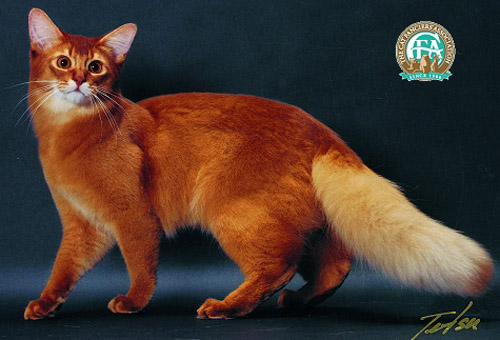


How did this marvelous breed come about? Basically, the Somali is a longhaired Abyssinian, the result of a recessive gene in the Abyssinian cat. How this gene was introduced into the Abyssinian gene pool is a subject of much speculation and controversy; nevertheless, it happened, and the result is our beautiful Somalis, for which we will be forever grateful! A recognized breed in CFA since 1979, Somalis have enjoyed many successes in the show ring. Nothing is more delightful to watch than an impeccably groomed Somali perform in the judging ring. A natural clown, the Somali will show itself to the fullest while playing with any toy a judge chooses. Whether in the judging ring or at home, the Somali shows an enthusiasm for living that makes it a wonderful companion and member of the family. The Somali is a well-proportioned medium sized cat with firm muscular development. The medium-length, soft and silky coat requires little grooming. The coat is longer around the ruff, tummy, and britches - with that lovely, fluffy, full tail. The feet have tufts of hair between the toes. The large, almond shaped eyes range in color from intense green to rich copper. The coat pattern is agouti (also called "ticked"), which has multiple bands of color on each hair. The Somali comes in four recognized colors in CFA: ruddy, red, blue, and fawn. The colors showing in the ticked fur of the back and tail harmonize with the solid, lighter color on the cat's undersides.  Pictured: Third Best of Breed GC, RW GENZI SUZAKU-TEI OF NYAN-NYAN, Red Somali Male Photo: © Tetsu Pricing on Somalis usually depends on type, applicable markings and bloodlines distinguished by Grand Champion (GC), National Regional winning parentage (NW or RW) or of Distinguished Merit parentage (DM). The DM title is achieved by the dam (mother) having produced five CFA grand champion/premier (alter) or DM offspring, or sire (father) having produced fifteen CFA grand champion/premier or DM offspring. Usually breeders make kittens available between twelve and sixteen weeks of age. After twelve weeks, kittens have had their basic inoculations and developed the physical and social stability needed for a new environment, showing, or being transported by air. Keeping such a rare treasure indoors, neutering or spaying and providing acceptable surfaces (e.g. scratching posts) for the natural behavior of scratching (CFA disapproves of declawing or tendonectomy surgery) are essential elements for maintaining a healthy, long and joyful life. There are CFA clubs devoted to the promotion, protection and preservation of the Somali breed. For more information, please send inquiries to CFA at cfa@cfa.org. Text: Tammy Roark Last Updated: Sunday, July 31, 2011
|
|||